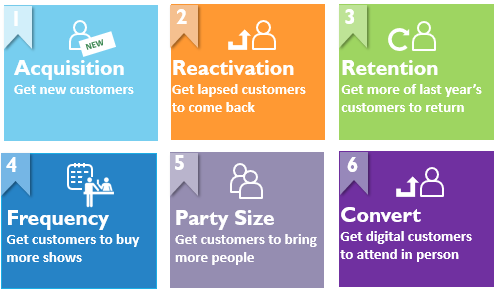MEASURE, ASK, ACT—Laying the Foundation for a Sustainable Audience

Jennifer Nemeth
Manager, Professional Services
Building a sustainable audience is a topic that is top-of-mind right now across the arts and culture industry. As we found in our study of sales trends in the fall of 2021, ticket sales are down 27%, and the drop in sales is particularly noteworthy for both subscription tickets and discounted tickets. The drop in subscription sales means that performing arts organizations’ core audience size is shrinking, putting more pressure on single ticket sales to make up the difference. On the flip side, discount buyers tend to be on the fringes of the audience, only motivated to attend when they receive a discount.
If we’re losing stability in the core of the audience, and missing those audience members who fill in around the edges, that paints a concerning picture for the future of the arts. For this reason, we need to be strategic and deliberate about how we build back audiences, using carefully analyzed data and being proactive.
There are three key pieces to building a sustainable audience strategy, and they are: MEASURE, ASK, and ACT.
MEASURE
The first step, MEASURE, is all about understanding your audience and how their makeup and behavior has changed over the past two years. It’s critical to challenge your own assumptions about who your audience is and what they buy, because while those assumptions may have been spot-on in the past, it’s not guaranteed they are still true today. Completing an analysis of your audience behavior is beneficial for many reasons, including to help you:
- Recognize changes in audience behavior.
- Create better forecasts.
- Keep up with trends.
- Challenge your own assumptions.
There are two key questions to answer when you’re doing this analysis, and they are:
- Who is coming back?
- What are they doing?
The first question, “Who is coming back?” is all about understanding how the makeup of your audience may have changed. Has the proportion of subscribers in your audience decreased? What about the number of “oncers”? Are your current ticket buyers returning attendees from previous years, or are they brand new? Understanding the answers to these questions is key to identifying the best way to communicate with your current and prospective audience.
The second question, “What are they doing?” will help you recognize your audience’s behaviors, and how your marketing and offerings might shift to align with them. For example, you might measure which titles or types of performances are most popular, and how that differs from several years ago. Or, you might measure by day of week to understand how buying patterns have shifted along with commuting and travel patterns. And of course, you’ll want to look at sales patterns by price and seat location, to recognize whether your pricing model still meets the needs of your audience and your organization.
These measurements allow you to identify soft spots that you may want to address, and the way to address them is by understanding what motivates your audience. What motivates them to subscribe, to purchase a ticket, and to attend? Which brings us to our second step, to ASK.
ASK
There are some big questions organizations need to ASK to create an effective strategy moving forward, including:
- How does our audience feel about us?
- What will motivate support?
- What do audiences need from us now?
The most effective tool for finding answers to these questions is primary research. At JCA Arts Marketing, we use a sophisticated primary research technique called conjoint analysis. While the database analysis shows us how the audience has acted in the past, conjoint analysis is excellent at predicting how people will act in the future.
Conjoint analysis uses forced-choice decision modeling to show how people value potential attributes of a product. The data from conjoint analysis is used to ensure that the most valuable attributes are present in your product, at the right price, to inspire consumer action. Conjoint analysis results in valuable data to help you make decisions about your offerings, including:
- A segmentation of audience members whose values and interests are similar.
- The relative appeal of different attributes of your offering. For a performance, those attributes could include genre, venue, or day of week. For a membership, you might test free tickets, parking discounts, or special member events.
- A price elasticity curve, which will show you the price elasticity of each audience segment.
- Revenue maximization prices. The revenue maximization price is the price at which you can expect to make the most revenue based on a balance of price and demand. You many find multiple revenue maximization points for each segment.
Conjoint analysis is a valuable tool for evaluating the attributes and prices of your offering and gaining an understanding of what your audience wants. Change is hard, but conjoint analysis ensures that you’re headed in the right direction for audience growth.
For an example of conjoint analysis, check out this case study from the Melbourne Symphony Orchestra.
ACT
The third step in building your strategy for a sustainable audience is to ACT by establishing your goals and creating a plan to reach them. When it comes to developing goals for audience growth, it will be helpful to break your larger goal into smaller, measurable goals, using your audience segmentation.
Remember that there are only six ways to increase sales volume, so your segment goals should include one of these:
- Acquisition
- Reactivation
- Retention
- Frequency
- Party Size
- Convert

A great way to organize your goals and tactics is to create a Segmentation Playbook. Your Segmentation Playbook should include two main features:
- A starting formation, which includes defining your segments and setting your initial strategies
- Your “plays”, which are the strategies you’ll have in your back pocket to make decision making easier down the line.
For more on creating your Segmentation Playbook, check out this blog.
These three steps: MEASURE, ASK, and ACT together will allow you to create the foundation for a strong audience sustainability strategy. If you need any help along the way, JCA Arts Marketing is here for you!

